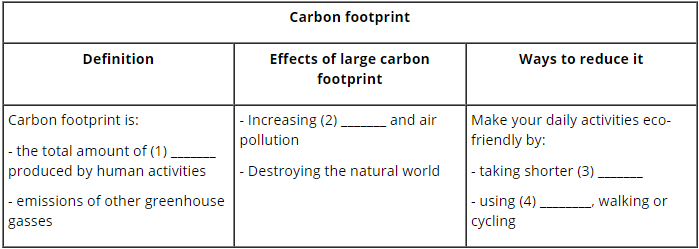Đừng bỏ lỡ những tính năng hấp dẫn của Baitap365.com
Unit 2: Humans and the environment
Tiếng Anh 10 Unit 2 Communication and culture / CLIL
Tiếng Anh 10 Unit 2 Looking back Tiếng Anh 10 Unit 2 Project Tiếng Anh 10 Unit 2 Writing Tiếng Anh 10 Unit 2 Listening Tiếng Anh 10 Unit 2 Speaking Tiếng Anh 10 Unit 2 Reading Tiếng Anh 10 Unit 2 Language Tiếng Anh 10 Unit 2 Getting Started Grammar Unit 2 Tiếng Anh 10 Global Success Luyện tập từ vựng Unit 2 Tiếng Anh 10 Global Success Tiếng Anh 10 Global Success Unit 2 Từ vựngTiếng Anh 10 Unit 2 Communication and culture / CLIL
1. Listen and complete the conversation with the expressions in the box. Then practise it in pairs. 2. Work in pairs. Make similar conversations asking for and giving advice about green living. Use the expressions below to help you. 1. Read the text and complete the table. 2. Work in pairs. Discuss things you can do to reduce your carbon footprint.
Everyday English - 1
Asking for and giving advice
1. Listen and complete the conversation with the expressions in the box. Then practise it in pairs.
(Nghe và hoàn thành cuộc hội thoại với các cụm trong hộp. Sau đó thực hành theo cặp.)
A. You should (Bạn nên)
B. What should I do (Tôi nên làm gì)
C. I advise you (Tôi khuyên bạn)
D. Should I (Tôi có nên...)
Lan: I was asked to give a presentation on climate change next week. (1) __________, Mai?
Mai: (2) __________ search for information about the topic on the internet.
Lan: (3) __________ also read books in the library?
Mai: That’s a good idea. (4) __________ to collect information from different sources. Then you can decide what to include in the presentation.
Everyday English - 2
2. Work in pairs. Make similar conversations asking for and giving advice about green living. Use the expressions below to help you.
(Làm việc theo cặp. Thực hiện các đoạn hội thoại tương tự để yêu cầu và đưa ra lời khuyên về lối sống xanh. Sử dụng các cụm từ dưới đây để giúp bạn.)

CLIL - 1
Carbon footprint (Dấu chân cac-bon)
1. Read the text and complete the table.
(Đọc bài đọc và hoàn thành bảng.)
A carbon footprint is the total amount of CO2 produced by human activities. It often also includes the emissions of other greenhouse gasses. Although calculating your carbon footprint can be difficult, you can still estimate it based on how big your family is, how much electricity your appliances use, how much you drive or fly, or how much you recycle.
Globally, the average carbon footprint per person is more than 4 tons per year. Too much CO2 in the Earth's atmosphere can cause serious problems. It can lead to increasing global temperatures and air pollution, and destroy the natural world.
It's not difficult to reduce your carbon footprint. You can do it by making your daily activities eco-friendly. For example, you can take shorter showers. The less hot water you use, the less energy is needed to heat the water. Instead of using your personal car or motorbike, you should use public transport, walk or cycle as much as possible.
These simple activities can help reduce your carbon footprint and your impact on the environment.

CLIL - 2
2. Work in pairs. Discuss things you can do to reduce your carbon footprint.
(Làm việc theo cặp. Thảo luận về những điều bạn có thể làm để giảm dấu chân carbon của mình.)
Từ vựng
1.
2.
climate change /ˈklaɪmət tʃeɪndʒ/ 

(n.phr): biến đổi khí hậu
I was asked to give a presentation on climate change next week.
(Tôi được yêu cầu thuyết trình về biến đổi khí hậu vào tuần tới.)
3.
collect information /kəˈlɛkt ˌɪnfəˈmeɪʃən/ 

(v.phr): thu thập thông tin
How do you collect information?
(Làm thế nào để bạn thu thập thông tin?)
4.
(n): phát thải
It often also includes the emissions of other greenhouse gases.
(Nó cũng thường bao gồm việc phát thải các khí nhà kính khác.)
5.
(v): tính toán
Although calculating your carbon footprint can be difficult, you can still estimate it based on how big your family is, how much electricity your appliances use, how much you drive or fly, or how much you recycle.
(Mặc dù việc tính toán lượng khí thải carbon của bạn có thể khó khăn, nhưng bạn vẫn có thể ước tính nó dựa trên quy mô gia đình của bạn, mức độ sử dụng điện của các thiết bị của bạn, mức độ bạn lái xe hoặc đi máy bay hoặc mức độ bạn tái chế.)
6.
global temperatures /ˈgləʊbəl ˈtɛmprɪʧəz/ 

(n.phr): nhiệt độ toàn cầu
It can lead to increasing global temperatures and air pollution, and destroy the natural world.
(Nó có thể dẫn đến việc tăng nhiệt độ toàn cầu và ô nhiễm không khí, đồng thời phá hủy thế giới tự nhiên.)
7.
(v): làm nóng
The less hot water you use, the less energy is needed to heat the water.
(Bạn sử dụng càng ít nước nóng thì càng cần ít năng lượng để làm nóng nước.)
8.
public transport /ˈpʌblɪk ˈtrænspɔːt/ 

(n.phr): phương tiện công cộng
Instead of using your personal car or motorbike, you should use public transport, walk or cycle as much as possible.
(Thay vì sử dụng ô tô hoặc xe máy cá nhân, bạn nên sử dụng phương tiện công cộng, đi bộ hoặc đạp xe càng nhiều càng tốt.)

9.
(n): sự tác động
These simple activities can help reduce your carbon footprint and your impact on the environment.
(Những hoạt động đơn giản này có thể giúp giảm lượng khí thải carbon của bạn và tác động của bạn đến môi trường.)
10.
(v.phr): tắm
For example, you can take shorter showers.
(Ví dụ, bạn có thể tắm trong thời gian ngắn hơn.)

11.
Mẹo tìm đáp án nhanh
Search Google: "từ khóa + baitap365" Ví dụ: "Bài 5 trang 13 SGK Vật lí 12 baitap365